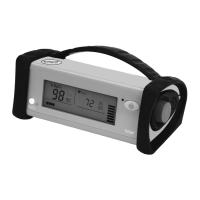Product Description and Specifications
1–9
Electromagnetic compatibility (EMC)
When using this monitor, take precautions to ensure electromagnetic compatibility.
Indications that the monitor is experiencing electromagnetic interference include,
for example, a dashed display or sudden changes in the pleth bar height that do not
correlate to the physiological condition of the patient. This interference may be
intermittent and careful correlation between the effect and its possible source is
important. Indications of interference should not occur if the monitor is used within
its intended electromagnetic environment.
Electromagnetic interference, including interference from portable and mobile radio
frequency (RF) communications equipment, can affect this monitor. When using the
monitor, take precautions to ensure electromagnetic compatibility.
Recommended Separation Distances between
Portable and Mobile RF Communications Equipment and the TruSat
The TruSat pulse oximeter is intended for use in an electromagnetic environment in which RF disturbances are
controlled. The customer or the user of the monitor can prevent electromagnetic interference by maintaining a
minimum distance between portable and mobile RF communications equipment (transmitters) and the monitor as
recommended below, according to the maximum output power of the communications equipment.
Separation distance according to the frequency of the transmitter
m
Rated maximum output
power of the transmitter
W
150 kHz to 80 MHz
80 MHz to 800 MHz 800 MHz to 2,5 GHz
0.01 0.07 0.07 0.07
0.1 0.22 0.22 0.22
1 0.70 0.70 0.70
10 2.2 2.2 2.2
100 7.0 7.0 7.0
For transmitters rated at a maximum output power not listed above, the recommended separation distance d in
meters (m) can be estimated using the equation applicable to the frequency of the transmitter, where P is the
maximum output power rating of the transmitter in watts (W) according to the transmitter manufacturer.
NOTE 1: At 80 MHz and 800 MHz, the separation distance for the higher frequency range applies.
NOTE 2: These guidelines may not apply in all situations. Electromagnetic propagation is affected by absorption
and reflection from structures, objects, and people.
Guidance and manufacturer’s declaration - electromagnetic emissions
The TruSat pulse oximeter is suitable for use in the electromagnetic environment specified below. The customer or the
user of the monitor should assure that it is used in such an environment.
Emissions test Compliance Electromagnetic environment - guidance
RF emissions
CISPR 11
Group 1
The TruSat uses RF energy only for its internal function.
Therefore, its RF emissions are very low and are not likely to
cause any interference in nearby electronic equipment.
RF emissions
CISPR 11
Class B
Harmonic emissions
IEC 61000-3-2
Class A
Voltage fluctuations/flicker emissions
IEC 61000-3-3
Complies
The TruSat is suitable for use in all establishments, including
domestic establishments and those directly connected to
the public low-voltage power supply network that supplies
buildings used for domestic purposes.

